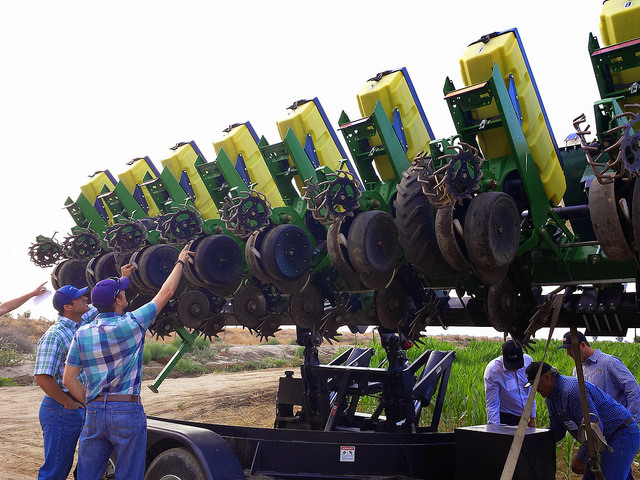
|
What is Conservation Tillage? Conservation tillage is a method of low-impact farming that leaves crop stubble on the surface of the soil, with farmers planting new crops right on top. The remaining crop residue protects the soil from erosion and prevents wind from blowing dirt into the air. It also requires fewer tractor passes to prepare fields for planting, dramatically reducing dust and diesel pollution. |
On August 5th, two-dozen dairy farmers joined Sustainable Conservation and California Ag Solutions for a daylong conservation tillage bus tour around the Central Valley that stopped at three different dairy farms. The purpose of the tour was to encourage farmers to shift from conventional farming techniques to strip-till as a way to improve their own bottom-line, while helping to clean up some of the state’s dirtiest air.
Cleaning up the Central Valley’s Air
Conventional farming techniques cause significant soil disturbance, effectively increasing dust pollution and diesel emissions. This method of farming is a major source of air pollution in the Central Valley.
This area in particular is known for its poor air quality, with at least 10% of the population – especially children and the elderly – suffer from a variety of respiratory problems and chronic breathing disorders. Increasingly worrisome is the fact that Fresno County, the leading farming region in the nation, has the country’s highest asthma mortality rate.
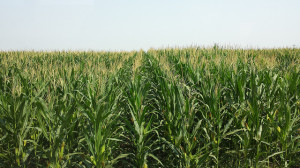 The tour encouraged Central Valley farmers to consider taking part in Sustainable Conservation’s strip-till equipment rental program, which allows them to try out strip-till without the upfront costs of investing in all-new equipment.
The tour encouraged Central Valley farmers to consider taking part in Sustainable Conservation’s strip-till equipment rental program, which allows them to try out strip-till without the upfront costs of investing in all-new equipment.
Side-by-Side: Strip-Till vs. Conventional Tillage
After meeting at the Hilmar Cheese Company’s Visitor’s Center bright and early, participants made the short drive to the Charles Ahlem Ranch, where the crowd was presented with a side-by-side comparison of a conventionally tilled field vs. a strip-tilled field.
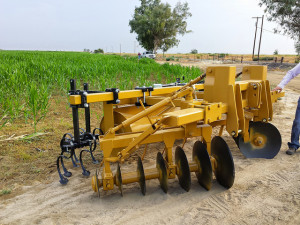 Most were surprised to find they couldn’t tell the difference between the till-methods, but as Steve Bello, the Farm Manager at Charles Ahlem Ranch, explained, differences certainly exist in terms of costs, water use, labor needed and time invested.
Most were surprised to find they couldn’t tell the difference between the till-methods, but as Steve Bello, the Farm Manager at Charles Ahlem Ranch, explained, differences certainly exist in terms of costs, water use, labor needed and time invested.
Whereas conventional tilling took five tractor passes to till its designated acreage, the strip-till method was able to cover the same acreage in only two passes. Fewer tractor passes ultimately means cleaner air as less carbon is released into the air, as well labor and fuel costs savings.
While at the Charles Ahlem Ranch, participants also got the opportunity to take a look at the actual strip-till equipment used, complete with a roaring demonstration of the strip-till planter.
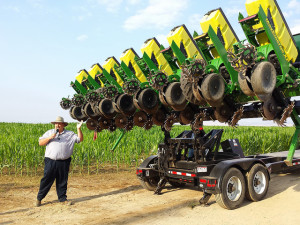 What was most impressive was the difference in the amount of fuel needed to complete the tilling. While traditional tilling consumes about 25 gallons of fuel per acre, strip-tilled fields only require one gallon per acre. Tractors running on diesel are responsible for releasing a good portion of the emissions leading to ozone and smog pollution.
What was most impressive was the difference in the amount of fuel needed to complete the tilling. While traditional tilling consumes about 25 gallons of fuel per acre, strip-tilled fields only require one gallon per acre. Tractors running on diesel are responsible for releasing a good portion of the emissions leading to ozone and smog pollution.
Precision Fertilizer: Reducing Environmental Impact
After completing the tour of the Charles Ahlem Ranch, participants took a trip to Clover Prairie Farms, which has successfully converted 100% of their fields to strip-till.
This was the first time the ranch had used the strip-till method, effectively establishing them as pioneers within the California dairy industry for using new technologies.
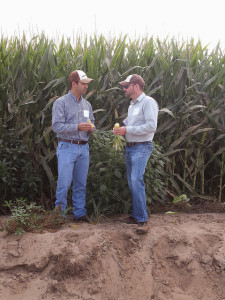 Folks took time to wander through the tall silage growing and almost ready for harvest and shucked some of the corn to take a look at the quality crops strip-till is yielding.
Folks took time to wander through the tall silage growing and almost ready for harvest and shucked some of the corn to take a look at the quality crops strip-till is yielding.
Partakers learned about the farm’s precision fertilizer efforts, which allows proper agronomic rates to be applied and places the plant food exactly where it is needed. This technology and practice increases the efficiency of fertilizer use, thereby reducing its environmental impact and saving the farmer money.
Reducing the amount of fertilizer used also decreases the potential for nitrogen to pollute It also helps with erosion control and helps the farm save at least $50 an acre in diesel costs due to using a lower horsepower engine and making fewer tractor passes.
Water-Conscious Farming
Most notable was that it took Clover Prairie Farms five days longer to irrigate the fields for conventionally tilled fields than strip-tilled fields because conventional tillage practices open up the soil, making it so that during irrigation events water must fill those gaps left, which effectively consumes much more water and takes much longer to irrigate.
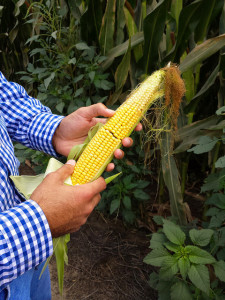 The strip-tilled fields were also more water efficient, as the residue matter left on the field helped the soil and roots stay moist and catalyzed better water distribution. The soil temperature underneath the growing corn, the manager emphasized, was twenty degrees cooler than the conventionally tilled fields. This is because the cover provided by the crop stubble protects the soil from the sun’s heat and helps reduce water evaporation from the soil. Such efficient water usage is integral in ensuring crop viability during drier periods when less water is available.
The strip-tilled fields were also more water efficient, as the residue matter left on the field helped the soil and roots stay moist and catalyzed better water distribution. The soil temperature underneath the growing corn, the manager emphasized, was twenty degrees cooler than the conventionally tilled fields. This is because the cover provided by the crop stubble protects the soil from the sun’s heat and helps reduce water evaporation from the soil. Such efficient water usage is integral in ensuring crop viability during drier periods when less water is available.
Flowmeters and Nutrient Management
Sustainable Conservation is also partnering with Clover Prairie Farms to install an extensive flowmeter project. The flowmeter project at Clover Prairie Dairy will consist of installing three flowmeters allowing the owners to measure the flow of their lagoon water during irrigation events.
Being able to measure the lagoon water enables dairy producers to accurately apply the correct amount of nutrients crops need, which also allows them to utilize the full potential of the nutrients, as well as assists the dairy in complying with regulations.
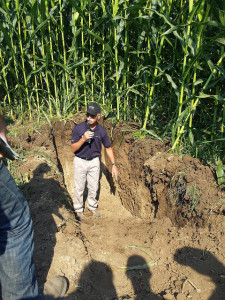 Promoting Increased Soil Quality
Promoting Increased Soil Quality
Our last stop was at the Joe & Renee Barosso Dairy, where the Barosso’s are undertaking strip-till for the first time. A pit dug a few feet down the day before revealed the roots and the effects of strip-till on the land’s soil.
Mike Peterson, a soil scientist with California Ag Solutions, climbed down into the hollowed out earth to show us how the use of strip-till promotes healthier soil by increasing water holding capacity, earth worm activity that naturally produces plant nutrients, and improving the root structure to allow them to grow deeper.
Strip-Till Equipment Rental Program
The tour ended with a lunch and information session about the conservation tillage equipment rental program back at the Hilmar Cheese Company (which by the way, has amazing cheese curds).
By the end of the event, a good number of the attending dairy producers had expressed interest in the rental program and in using strip-till on their own fields.
|
Results of Conservation Tillage • Farmers using conservation tillage can reduce their dust emissions by up to 70% and diesel emissions by up to 50%. • In 2010 alone, conservation tillage helped farmers save over $16 million in fuel, labor and maintenance costs. • Since 2003, Sustainable Conservation has helped California farmers make the switch to low-impact farming methods on 300,000 acres across nine counties. |
Imagine the improvements to the Central Valley’s air and water quality if low-impact farming techniques are adopted.
These progressive dairy producers, with an eye on conservation and cost effectiveness, can be integral in enabling their communities to breathe easier, while boosting local farm economies.
To learn more about our conservation tillage equipment rental program, please contact Ladi Asgill via e-mail at LAsgill@suscon.org.
Read more about our conservation tillage work here. And checkout the full album of photos from the strip-till tour here.
